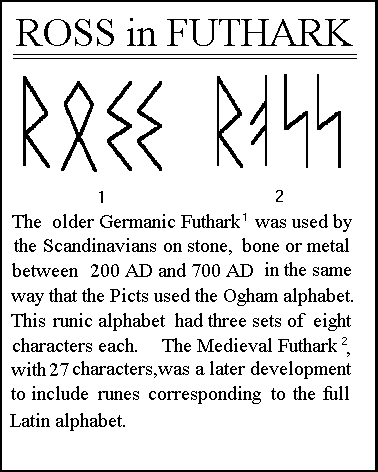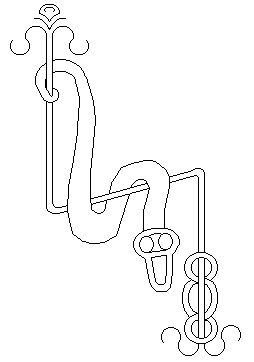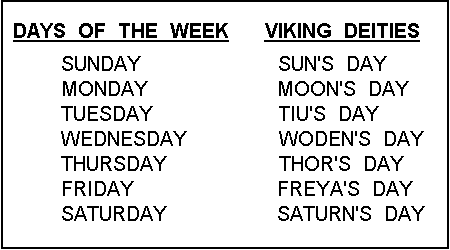
III - NORSE VIKING RAIDS ... THE SCOTS TAKE OVER
REFERENCES:The Roman departure from the British Isles was partly due to the invasion of Europe and the Roman Empire by the Huns (372 AD - 453 AD). Attila's hordes were also responsible for the dispersal of many Teutonic tribes. Among these were the people who would populate Scandinavia: the Norse (Norwegian) Vikings and the Danish Vikings and the Swedes. Unlike the Picts, the Scandinavians had remained in Europe long enough for their Runic language (Old Futhark) to be greatly influenced by the steady incursion of the linguistically-ancestral peoples from the Balkan peninsula and the grassy steppes north of the Black Sea and the Caspian Sea between 4000 and 2000 BC, and to be classified as strongly Indo-European.  The Norse looted Western Scottish monasteries (793 - 806), established resorts in the Inner and Outer Hebrides until they settled Skye and Lewis at the beginning of the 9th century AD, settled parts of northeast Ireland, evicted Danish Vikings from the Shetlands and Orkneys, and went on to settle Iceland (870 AD) and Greenland (900 AD) before exploring the Atlantic Coast of Canada (1000 AD). The Danes slowly established settlements in England and, in general, none of the native Britons or Angles were able to stop these Northmen in any significant way. The northern Picts and Scots seemed to have something in common with the Norse Vikings; intermarriages, common in Caithness and Sutherland, were even more extensive throughout the Western Isles.
The Norse looted Western Scottish monasteries (793 - 806), established resorts in the Inner and Outer Hebrides until they settled Skye and Lewis at the beginning of the 9th century AD, settled parts of northeast Ireland, evicted Danish Vikings from the Shetlands and Orkneys, and went on to settle Iceland (870 AD) and Greenland (900 AD) before exploring the Atlantic Coast of Canada (1000 AD). The Danes slowly established settlements in England and, in general, none of the native Britons or Angles were able to stop these Northmen in any significant way. The northern Picts and Scots seemed to have something in common with the Norse Vikings; intermarriages, common in Caithness and Sutherland, were even more extensive throughout the Western Isles.The 8th century British historian, Bede, noted that Pictish royal succession was through the female royal line. Pictish kings were not succeeded by their sons, but by their brothers or nephews or cousins in this rare matrilineal society, which was complicated by a series of intermarriages between seven royal houses. [This is also corroborated by The Pictish Chronicle.] These traditions and others would eventually be carried forward into the new Scotland. The Annals of Ulster record a battle near Perth in 839 AD between the Picts and Norsemen, in which the Pictish King Uven Mac Angus (son of Oengus II), his brother Bran, kinsmen and chief nobles were all slain. Left leaderless, the Picts of the southern kingdom passed swiftly in 845AD under the control of Kenneth Mac Alpin, the king of Scots of Dalriada. Since Kenneth I was the son of Alpin and a Pictish princess descended from the royal house of Fortrinn, he had a claim to the Pictish throne through the Pictish matrilineal law of succession. [Alpin's kingship over the Scots had been taken over by Pictish King Oengus I, who was the first king of both Picts and Scots from about 741 to 761 AD.] A rival Scots kindred, the Cenel Loairn, took over the role of the Pictish high kings in Moray and Ross, and his descendants challenged the successors of Kenneth I for the right to rule Scotland until the 13th century, by which time the Pictish society and culture had been completely assimilated by the Scots. Pictish "Symbol Stones" and art would come to an end.  Meanwhile, Easter Ross had become a borderland, a unique zone where Picts, Scots and Norse intermingled and collided. The sagas around 890 AD tell of "resorts" under Norse control as far south as Loch Ness and of a further extension of their influence to Moray from 1014 to 1064 AD. Places, such as Cadboll, Arboll, Bindal "sheaf-valley", Shandwick "Sand-vik or Sandy Bay", Dingwall "Thing vollr or Place of the Parliament", Falls of Rogie "Roke-_ or splashing foaming river", Gizzen Briggs, and other sites, retain Viking names.
Meanwhile, Easter Ross had become a borderland, a unique zone where Picts, Scots and Norse intermingled and collided. The sagas around 890 AD tell of "resorts" under Norse control as far south as Loch Ness and of a further extension of their influence to Moray from 1014 to 1064 AD. Places, such as Cadboll, Arboll, Bindal "sheaf-valley", Shandwick "Sand-vik or Sandy Bay", Dingwall "Thing vollr or Place of the Parliament", Falls of Rogie "Roke-_ or splashing foaming river", Gizzen Briggs, and other sites, retain Viking names.Legend has it that Port an Righ (Bay of the Kings) on the Black Isle is the site where a ship holding three Viking kings was wrecked in the 10th century. Cairn Irenan still marks the spot on the Kilcoy estate (Killearnan Parish, Black Isle), where the Viking prince Irenan was felled in battle and buried.  In or around the year 995, Norseman Sigurd the Stout was challenged to a pitched summer's battle in Caithness by Findlaec, mormaer of Moray [and father of Macbeth, the future King of Scots]. Three men who carried his finely embroidered raven-banner were killed, but Sigurd was able to claim a victory of sorts.
In or around the year 995, Norseman Sigurd the Stout was challenged to a pitched summer's battle in Caithness by Findlaec, mormaer of Moray [and father of Macbeth, the future King of Scots]. Three men who carried his finely embroidered raven-banner were killed, but Sigurd was able to claim a victory of sorts.History was to demonstrate how much influence the "Northern Teutonic tribes" would have upon the British Isles. The Norse were credited with forays as far as the Mediterranean and Baltic seas around 700 AD. In 910, they settled the Normandy area of France more permanently and, as Normans, they invaded the Angles in 1066. _______________ Sources beyond those already listed were consulted, as follows: - Eric Linklater, The Ultimate Viking. Macmillan, 1955. - East Ross and Black Isle, Official Guide. East Ross and Black Isle Tourist Organization, Muir od Ord, Ross-shire. - Frank Adam, FRGS, FSA (Scot), Clans, Septs and Regiments of the Scottish Highlands ... "Ancient Alba and the Rise of the Hughland Clan System". 8th Ed. Johnston and Bacon, Edinburgh and London, 1970. - William Croft Dickinson, A New History of Scotland, Vol.I. Thomas Nelson and Sons, Ltd.: Edinburgh. 1962. - Rosalind Mitchison, A History of Scotland, Methuen: London. 1970. Useful material on the Runic Alphabet or Futhark was also found on the internet at the following websites: - The Old Norse Futhark, updated 96-08-15, by Johan Nordlander. - Runes, updated June 2, 1996. The Viking Network. Due to the nature of the internet, sources can disappear for a variety of reasons, and new ones may be discovered by using key words when you are doing a search [e.g. "Futharkana" or "The Runic Journey"] |





